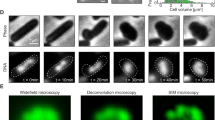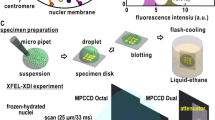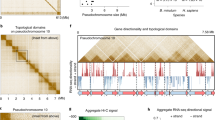Abstract
By using the optical properties of birefringence of DNA, the arrangement of these molecules has been studied in Dinoflagellate chromosomes and Dipteran polytene chromosomes. These latter are used, here, as a reference material. These observations have been made under a polarizing microscope on intact and stretched chromosomes. — Intact Dinoflagellate chromosomes show a positive birefringence, in contrast with polytene chromosomes bands which are negatively birefringent. From these observations one can deduce the preferential orientation of DNA filaments, in Dinoflagellates, normal to the chromosome axis, and in polytene chromosomes parallel to the same axis. — After stretching, these two kinds of chromosomes are negatively birefringent. In both cases, DNA molecules have been aligned along the stretch axis. — In Dinoflagellate chromosomes the passage from a positive to a negative birefringence is realized without any isotropic stage. The intermediary state presents a biaxial structure.
Similar content being viewed by others
References
Alfert, M.: Composition and structure of giant chromosomes. Int. Rev. Cytol. 3, 131–175 (1955)
Angelo, E.G. d': Micrurgical studies on Chironomus salivary gland chromosomes. Biol. Bull. 90, 71–87 (1946)
Angelo, E.G. d': Salivary gland chromosomes. Ann. N.Y. Sci. 50, 815–1012 (1950)
Bouligand, Y.: Sur l'existence de “pseudomorphose cholestériques chez divers organismes vivants. J. de Phys. 30, C 4 , 90–103 (1969)
Bouligand, Y., Soyer, M.O., Puiseux-Dao, S.: La structure fibrillaire et l'orientation des chromosomes chez les Dinoflagellés. Chromosoma (Berl.) 24, 251–287 (1968)
Caspersson, T.: Nukleinsaüreketten und Genvermehrung. Chromosoma (Berl.) 1, 605–619 (1940)
Ephrussi, B., Beadle, G.W.: A technique of transplantation for Drosophila. Amer. Naturalist 70, 218–225 (1936)
Frey-Wyssling, A.: Submicroscopic morphology of protoplasm. Amsterdam: Elsevier 1953
Grassé, P.P., Hollande, A., Cachon, J., Cachon-Enjumet, M.: Nouvelle interprétation de l'ultrastructure fine du chromosome de certains Péridiniens. C.R. Acad. Sci. (Paris) 260, 1743–1747 (1965)
Haapala, O.K., Soyer, M.O.: Structure of Dinoflagellate chromosomes. Nature (Lond.) New Biol. 244, 195–197 (1973)
Inoué, S., Sato, M.: Arrangement of DNA in living sperm: a biophysical analysis. Science 136, 1122–1124 (1962)
Inoué, S., Sato, M.: Deoxyribonucleic acid arrangement in living sperm. In: Molecular architecture in cell physiology (T. Hayashi and A.G. Szent-Gyorgyi, eds.) pp. 209–233, 1966
Langridge, R., Wilson, J.R., Hooper, C.W., Wilkins, M.H.F., Hamilton, L.D.: The molecular configuration of deoxyribonucleic acid. J. molec Biol. 2, 19–37 (1960)
Lezzi, M., Gilbert, L.I.: Differential effects of K+ and Na+ on specific bands of isolated polytene chromosomes of Chironomus tentans. J. Cell Sci. 6, 615–627 (1970)
Livolant, F., Bouligand, Y.: New observations on the twisted arrangement of Dinoflagellate chromosomes. Chromosoma (Berl.) 00, 000–000 (1978)
Pfeiffer, H.H.: Mikrurgisch-polarisationsoptische Beiträge zur submikroskopischen Morphologie larvaler Speicheldrüsenchromosomen von Chironomus. Chromosoma (Berl.) 2, 77–85 (1941)
Rizzo, P.J., Nooden L.D.: Isolation and chemical composition of Dinoflagellate nuclei. J. Protozool. 20, 666–672 (1973)
Schmidt, W.J.: Zur Doppelbrechung der Chromosomen in den Speicheldrüsenkernen der Chironomuslarven. Naturwissenschaften 25, 506–507 (1937)
Schmidt, W.J.: Herstellung von Präparaten zur Polarisation optischen Untersuchung der Chromosomen in der Speicheldrüsenkernen der Chironomus-Larven. Z. Wiss. Mikr. 56, 1–7 (1939)
Schmidt, W.J.: Einiges über optische Anisotropie und Feinbau von Chromatin und Chromosomen. Chromosoma (Berl.) 2, 86–110 (1941)
Schmitt, F.O.: Optical studies of the molecular organization of living systems. J. appl. Physics 9, 109–117 (1938)
Seeds, W.E., Wilkins, M.H.F.: Ultraviolet microspectrographic studies of biological interest. Faraday Soc. Discussion 9, 417–423 (1950)
Skaer, R.J., Whytock, S.: The fixation of nuclei and chromosomes. J. Cell Sci. 20, 221–231 (1976)
Sorsa, V., Virrankoski-Castrodeza, V.: Whole mount electron microscopy of alkali urea treated polytene chromosomes spread by centrifugation. Hereditas (Lund) 82, 131–135 (1976)
Ullrich, H.: Einige beobachtungen über Doppelbrechung am lebenden Protoplasten, an Verschiedenen Zellorganellen sowie der Zellwand. Planta (Berl.) 26, 311–318 (1936)
Author information
Authors and Affiliations
Rights and permissions
About this article
Cite this article
Livolant, F. Positive and negative birefringence in chromosomes. Chromosoma 68, 45–58 (1978). https://doi.org/10.1007/BF00330371
Received:
Accepted:
Issue Date:
DOI: https://doi.org/10.1007/BF00330371




